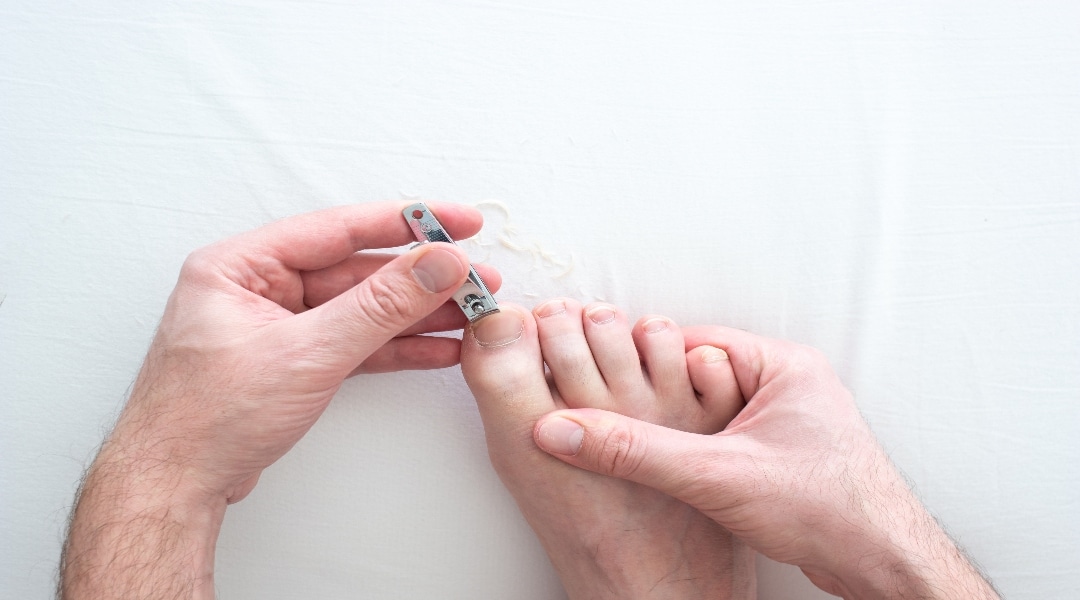4 Simple Tips to Correctly Cut Your Toenails
Some people may find the idea of a guide to trimming their toenails rather silly. Isn’t this just something everyone naturally learns on their own?
But just because you have always trimmed your toenails a certain way doesn’t necessarily mean that’s the proper way. It may surprise you to know that, in many cases, the way people trim their toenails is one of the main reasons they eventually need to see us about their recurring ingrown toenails and other painful problems!
It’s never too late to learn some new tricks for toenail trimming. Check out the tips below, and never hesitate to contact us if you have any questions or concerns not covered here.
The Big Question: Cut Curved or Cut Straight?
If any debate about toenail trimming is going to boil over, it will likely be on this topic. Is it better to trim your toenails straight across, or curve in the corners?
Well, if you want to reduce your chances of ingrown toenails, the best route is straight across. A straight trim will help ensure your toenails grow forward as they should. Curved edges provide more opportunity for your nails to grow into your skin instead.
If you are concerned about the corners of your nails poking against you or catching on your socks, gently file them down instead of clipping them off. A very slight amount of roundness is OK there.
Do Not Cut Your Toenails Too Short
The white area at the tips of your nails should never be fully removed. If you don’t leave at least a small “slice” of it remaining, you are cutting your nails way too short and risking painful damage to your nail bed.
A good range is about 1-2 mm of white – enough so you’re not cutting too deeply, but not extending past the toes and risking the nails becoming caught or torn.
On average, toenails grow at about 1-2 mm per month. Clipping every 6-8 weeks tends to be a good rate for most people.
Use the Right Tools for the Job
Not all clippers are made equal – and the best tool for your toenails may not be the same as the one for your fingernails!
Fingernail clippers are generally smaller, have less leverage and cutting power, and produce a more curved cut. This tends to be fine for smaller, thinner fingernails. Try to use them on thicker, larger toenails, however, and it can cause trouble. You will need more clips to get through a larger toenail, which provides many more opportunities for jaggedness and tearing.
Another reason you don’t want to use fingernail clippers for your toes and vice versa? Using the same clippers on both hands and feet is a good way to transfer fungus from one location to the other! Keep your clippers restricted to hands or feet only.
A good pair of toenail clippers should also be a clean pair of toenail clippers. Wipe them down regularly with rubbing alcohol to get rid of any hitchhiking germs or fungus, and outright replace them if they’re starting to look broken down or nasty.
Do You Need to Soften Your Toenails?
Are your toenails normally so thick that it takes a good deal of effort to get your clippers through them?
Don’t try to force the issue if you don’t have to. That can make it all too easy to slip with your clippers and either tear your nails or injure yourself.
Instead, try working on your toenails after a shower or bath, when the nail tissue tends to be softer and potentially easier to work with. Getting through your nails can take much less effort, and you have the added bonus of your feet being clean before you get to work! Just make sure you fully dry your feet before you start clipping, just to reduce the risk of slipping.
That being said, if you normally clip your toenails with no problems, don’t attempt to do so right after a shower or bath. There is such a thing as your nails being too soft to work with, and trying to clip them at this time may lead to tearing.
Do You Need Help with Further Nail Problems?
Proper nail trimming habits can go a long way toward helping your feet stay looking and feeling great – but sometimes there are other problems that need some professional attention.
If you are facing any of the conditions below, please don’t hesitate to give us a call about them!
- Painful ingrown toenails (especially if you suspect an infection)
- Recurring ingrown toenails (even after you change your trimming habits)
- Fungal infections (thick, brittle, crumbly, and even unpleasant smelling nails)
- Black or otherwise discolored toenails
- Nails that are falling off
We can help you get to the root of the problem and recommend a course of action to achieve a healthier and more comfortable situation on your feet. Perhaps our advanced Remy Laser treatment will help eradicate a fungal infection, or you need a simple in-office procedure to remove an ingrown toenail for good.
We have seven offices throughout the greater Chicago area ready to help you. Schedule an appointment by using our online contact form, or by calling any of our offices directly.

